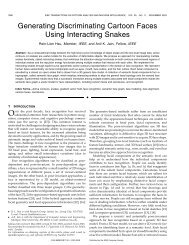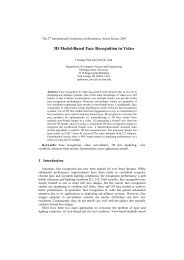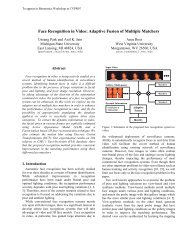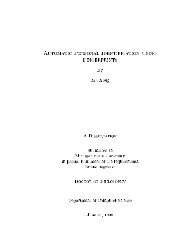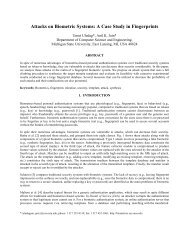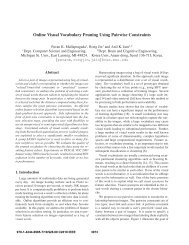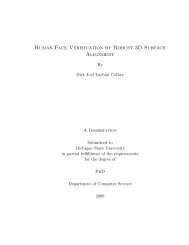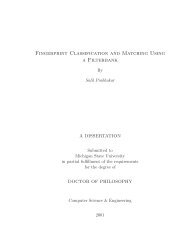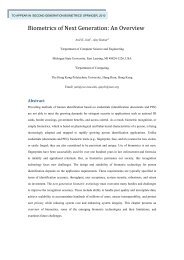Face Detection and Modeling for Recognition - Biometrics Research ...
Face Detection and Modeling for Recognition - Biometrics Research ...
Face Detection and Modeling for Recognition - Biometrics Research ...
You also want an ePaper? Increase the reach of your titles
YUMPU automatically turns print PDFs into web optimized ePapers that Google loves.
segment. The other term favors an upright face, <strong>and</strong> is a projection of a vector ⃗v 2<br />
(from the mouth to the midpoint of the two eyes) along the vertical axis ( ⃗u 2 ) of the<br />
image plane. The exponential function, shown in Fig. 3.14, is designed such that the<br />
attenuation has the maximal value of 1 when θ 1 = θ 2 = 0 ◦ (i.e., when eyes <strong>and</strong> mouth<br />
<strong>for</strong>m a letter “T” or equivalently the face is upright), <strong>and</strong> it decreases to below 0.5<br />
at θ 1 = θ 2 = 25 ◦ . The quality of face boundary, q(i, j, k), can be directly obtained<br />
from the votes received by the best elliptical face boundary in the Hough trans<strong>for</strong>m.<br />
Eye i<br />
V 2<br />
u 1<br />
Eye j<br />
u 2<br />
1<br />
V 1<br />
2<br />
1<br />
Mouth k<br />
Figure 3.13. Geometry of an eye-mouth triangle, where ⃗v 1 = −⃗v 2 ; unit vectors ⃗u 1 <strong>and</strong><br />
⃗u 2 are perpendicular to the interocular segment <strong>and</strong> the horizontal axis, respectively.<br />
Figure 3.14. Attenuation term, e −3(1−cos2 (θ r(i,j,k))) , plotted as a function of the angle<br />
θ r (in degrees) has a maximal value of 1 at θ r = 0 ◦ , <strong>and</strong> a value of 0.5 at θ r = 25 ◦ .<br />
81



